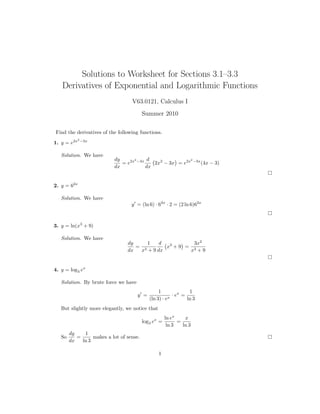
Lesson 8: Derivatives of Logarithmic and Exponential Functions (worksheet solutions)
- 1. Solutions to Worksheet for Sections 3.1–3.3 Derivatives of Exponential and Logarithmic Functions V63.0121, Calculus I Summer 2010 Find the derivatives of the following functions. 2 −3x 1. y = e2x Solution. We have dy 2 d 2 = e2x −3x 2x2 − 3x = e2x −3x (4x − 3) dx dx 2. y = 62x Solution. We have y = (ln 6) · 62x · 2 = (2 ln 6)62x 3. y = ln(x3 + 9) Solution. We have dy 1 d 3x2 = 3 x3 + 9 = 3 dx x + 9 dx x +9 4. y = log3 ex Solution. By brute force we have 1 1 y = · ex = (ln 3) · ex ln 3 But slightly more elegantly, we notice that ln ex x log3 ex = = ln 3 ln 3 dy 1 So = makes a lot of sense. dx ln 3 1
- 2. 5. y = log10 3θ2 −θ Solution. dy 1 2 −1/2 1 2 = log10 3θ −θ · θ 2 −θ · (ln 3) · 3θ −θ (2θ − 1) dx 2 (ln 10)3 ln 3 2θ − 1 = · 2 ln 10 log10 3θ2 −θ There’s some simplifications we could do before differentiation, however. 2 −θ ln 3θ θ2 − θ ln 3 ln 3 2 θ 2 −θ log10 3 = = = θ −θ ln 10 ln 10 ln 10 So ln 3 y= · θ2 − θ ln 10 ln 3 2θ − 1 y = · √ ln 10 2 θ2 − θ 6. y = sin2 x + 2sin x Solution. y = 2 sin x cos x + 2sin x · ln 2 · cos x Use logarithmic differentiation to find the derivatives of the following functions. 7. y = x x2 − 1 Solution. We have 1 ln(x2 − 1) ln y = ln x + 2 1 dy 1 1 2x = + · 2 y dx x 2 x −1 dy 1 x = x x2 − 1 + 2 dx x x −1 8. y = (x − 1)(x − 2)(x − 3) 2
- 3. Solution. We have 1 ln y = (ln(x − 1) + ln(x − 2) + ln(x − 3)) 2 1 dy 1 1 1 1 = + + y dx 2 x−1 x−2 x−3 dy 1 1 1 1 = (x − 1)(x − 2)(x − 3) + + dx 2 x−1 x−2 x−3 x(x − 1)3/2 9. y = √ x+1 Solution. We have 3 1 ln y = ln x +ln(x − 1) − ln(x + 1) 2 2 1 dy 1 3 1 1 1 = + · − · y dx x 2 x−1 2 x+1 dy x(x − 1)3/2 1 3 1 1 1 = √ + · − · dx x+1 x 2 x−1 2 x+1 3
